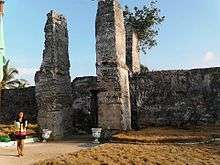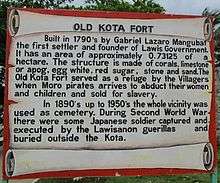Presidio de Lawis
Presidio de Lawis known more commonly as the Kota or fort[1] [2], was a Spanish fortification laid-down around 1628-1630[3] in the northernmost tip of an island called Bantayan in central Philippines by the Cebuano Visayan Spanish Army that became the nucleus of the modern-day municipalities of Madridejos , Bantayan, and Santa Fe, Philippines. The edifice is the Philippines oldest surviving Spanish Military Fort, older than the current structure of Fort San Pedro built in 1739, the current structure of Fort Pilar 1666[4] in Zamboanga ; the Fort San José in Cavite was abolished during the US regime ; completely destroyed during World War 2 ; while the current structure of Fort Santiago in Manila is only a replica (original Spanish structure was destroyed during the Second World War).


History
It was long believed and accepted that the Fort in Madridejos was only built around 1790s[5]
in fact the Fort's historical marker inscribed year 1790 as the date of fort's foundation posted out side the Fort's structure to served as guide for local and foreign tourist visiting the town.
Madridejos history scholar Brient Mangubat who have studied Bantayan Island History and the Lawis Old Fort foundation in Madridejos argued that
"the Kota was laid-down around 1628-1630 and not in 1790s. Constructed right after the moro raid in year 1628".
He also claimed that the origin of the Island's name Bantayan have nothing to do with the Muslim raiders
according to him the Island got its name (Bantayan) way back in year 1574, when the Island's northern side (LAWIS) , was used as a" Lookout post" after Da-an Bantayan by the Cebuano mainlander to monitor the Visyan Sea against Chinese, as Manila the country's capital city was under attack by the forces led by Limahong.
and the Island's name (Bantayan) was already used 25 years earlier,
before the (first) Muslim raid took place on Bantayan Island in year 1600.
References
- Lavilles, Gervasio L. (1965). History: Cebu's 4 cities & 49 municipalities with trimmed accounts of Christianization of the Philippines. Lavilles. p. 92. Retrieved 1 March 2020.
- "Madridejos wants to fix landmark". Sunstar Cebu News. Retrieved 29 February 2020.
- "Chapter 7: Promoting Philippine Culture and Values" (PDF). List of Priority Programs and Projects in the 2017-2022 Public Investment Programs (PIP)*. National Economic and Development Authority Philippines. p. 2. Retrieved 28 February 2020.
- Orendain, Antonio (1984). Zamboanga hermosa: memories of the old town. Zamboanga City (Philippines): Filipinas Foundation, 1984. p. 66, 254. Retrieved 10 February 2020.
- Javellana, Rene (1997). Fortress of Empire: Spanish Colonial Fortifications of the Philippines, 1565-1898. p. 209. Retrieved 22 May 2020.